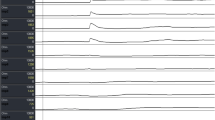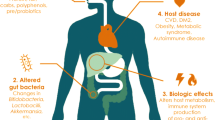Abstract
Digestion and absorption of a meal are time-intensive processes. To optimize digestion and absorption, transit of the meal through the gastrointestinal tract is regulated by a complex integration of neuropeptidergic signals generated as the jejunal brake and ileal brake response to nutrients. Mediators involved in the slowing of transit responses include peptide YY (PYY), chemosensitive afferent neurons, intestinofugal nerves, noradrenergic nerves, myenteric serotonergic neurons, and opioid neurons. The activation of this circuitry modifies the peristaltic reflex to convert the intestinal motility pattern from propagative to segmenting. Fat is the most potent trigger of these transit control mechanisms. The integrated circuitry of gut peptides and neurons involved in transit control in response to nutrients is described in this review.
Similar content being viewed by others
References and Recommended Reading
Holgate AM, Read NW: Can a rapid small bowel transit limit absorption? Gut 1982, 23:A912.
Lin HC, Doty JE, Reedy TJ, Meyer JH: Inhibition of gastric emptying by glucose depends on length of intestine exposed to nutrient. Am J Physiol 1989, 256:G404-G411
Lin HC, Doty JE, Reedy TJ, Meyer JH: Inhibition of gastric emptying by sodium oleate depends on length of intestine exposed to nutrient. Am J Physiol 1990, 259:G1031-G1036.
Zhao XT, Miller RH, McCamish MA, et al.: Protein absorption depends on load-dependent inhibition of intestinal transit in dogs. Am J Clin Nutr 1996, 64:319–323.
Spiller RC, Trotman IF, Adrian TE, et al.: Further characterisation of the "ileal brake" reflex in man—effect of ileal infusion of partial digests of fat, protein, and starch on jejunal motility and release of neurotensin, enteroglucagon, and peptide YY. Gut 1988, 29:1042–1051.
Meyer JH, Kelly GA: Canine pancreatic responses to intestinally perfused proteins and protein digests. Am J Physiol 1976, 231:678–681.
Meyer JH, Kelly GA, Jones RS: Canine pancreatic responses to intestinally perfused oligopeptides. Am J Physiol 1976, 231:682–691.
Lin HC, Zhao XT, Wang L: Jejunal brake: inhibition of intestinal transit by fat in the proximal small intestine. Digest Dis Sci 1996, 41:326–329.
Read NW, McFarlane A, Kinsman RI, et al.: Effect of infusion of nutrient solutions into the ileum on gastrointestinal transit and plasma levels of neurotensin and enteroglucagon. Gastroenterology 1984, 86:274–280.
Spiller RC, Trotman IF, Higgins BE, et al.: The ileal brake-inhibition of jejunal motility after ileal fat perfusion in man. Gut 1984, 25:365–374.
Woolf GM, Miller C, Kurian R, Jeejeebhoy KN: Diet for patients with a short bowel: high fat or high carbohydrate? Gastroenterology 1983, 84:823–828.
Lin HC, Zhao XT, Wang L: Intestinal transit is more potently inhibited by fat in the distal (ileal brake) than in the proximal (jejunal brake) gut. Digest Dis Sci 1997, 42:19–25.
Reynell P, Spray G. Small intestinal function in the rat after massive resections. Gastroenterology 1956, 31:361–368.
Kremen AJ, Linner JH, Nelson CH. An experimental evaluation of the nutritional importance of proximal and distal small intestine. Ann Surg 1954, 140:439–448. Fat maldigestion/malabsorption is worse when the distal versus proximal half of the small intestine is taken out of continuity.
Lin HC, Zhao XT, Chu AW, et al.: Fiber-supplemented enteral formula slows intestinal transit by intensifying inhibitory feedback from the distal gut. Am J Clin Nutr 1997, 65:1840–1844. Fiber-supplemented enteral formula slows intestinal transit by displacing nutrients to the more potent ileal brake response.
Jain NK, Boivin M, Zinsmeister AR, et al.: Effect of ileal perfusion of carbohydrates and amylase inhibitor on gastrointestinal hormones and emptying. Gastroenterology 1989, 96:377–387.
Jain NK, Boivin M, Zinsmeister AR, DiMagno EP: The ileum and carbohydrate-mediated feedback regulation of postprandial pancreaticobiliary secretion in normal humans. Pancreas 1991, 6:495–505.
Lin HC, Kim BH, Elashoff JD, et al.: Gastric emptying of solid food is most potently inhibited by carbohydrate in the canine distal ileum. Gastroenterology 1992, 102:793–801.
Lin HC, Moller NA, Wolinsky MM, et al.: Sustained slowing effect of lentils on gastric emptying of solids in humans and dogs. Gastroenterology 1992, 102:787–792.
Zhao XT, McCamish MA, Miller RH, et al.: Intestinal transit and absorption of soy protein in dogs depend on load and degree of protein hydrolysis. J Nutr 1997, 127:2350–2356.
Shankardass K, Chuchmach S, Chelswick K, et al.: Bowel function of long-term tube-fed patients consuming formulae with and without dietaryfiber. JPEN J Parenter Enter Nutr 1990, 14:508–512.
Siegle ML, Ehrlein HJ: Digestive motor patterns and transit of luminal contents in canine ileum. Am J Physiol 1988, 254:G552-G559.
Brown NJ, Read NW, Richardson A, et al.: Characteristics of lipid substances activating the ileal brake in the rat. Gut 1990, 31:1126–1129.
Cherbut C, Aube AC, Blottiere HM, Galmiche JP: Effects of short-chain fatty acids on gastrointestinal motility. Scand J Gastroenterol 1997, 222(Suppl):58–61.
Meyer JH, Elashoff JD, Domeck M, et al.: Control of canine gastric emptying of fat by lipolytic products. Am J Physiol 1994, 266:G1017-G1035.
Homann HH, Kemen M, Fuessenich et al.: Reduction in diarrhea incidence by soluble fiber in patients receiving total or supplemental enteral nutrition. JPEN J Parenter Enter Nutr 1994, 18:486–490.
Nakao M, Ogura Y, Satake S, et al.: Usefulness of soluble dietary fiber for the treatment of diarrhea during enteral nutrition in elderly patients. Nutrition 2002, 18:35–39.
Bueno L, Praddaude F, Fioramonti J, Ruckebusch Y: Effect of dietary fiber on gastrointestinal motility and jejunal transit time in dogs. Gastroenterology 1981, 80:701–707.
Eisenberg P: An overview of diarrhea in the patient receiving enteral nutrition. Gastroenterol Nursing 2002, 25:95–104.
Spapen H: Soluble fiber reduces the incidence of diarrhea in septic patients receiving total enteral nutrition: a prospective, double-blind, randomized, and controlled trial. Clin Nutr 2001, 20:301–305.
Postuma R: Extreme short-bowel syndrome in an infant. J Pediatr Surg 1983, 18:264–268.
Mei N: Recent studies on intestinal vagal afferent innervation. Functional implications. J Autonom Nerv Syst 1983, 9:199–206.
Randich A: Responses of celiac and cervical vagal afferents to infusions of lipids in the jejunum or ileum of the rat. Am J Physiol Regul Integr Compar Physiol 2000, 278:R34-R43.
Anthone GJ, Wang BH, Zinner MJ, et al.: Meal-induced jejunal absorption requires intact neural pathways. Am J Surg 1992, 163:150–156.
Lin HC, Chen JH: Slowing of intestinal transit by fat depends on an oxethezaine-sensitive afferent pathway. Gastroenterology 2002, 122:A62.
Stanley S, Wynne K, Bloom: Gastrointestinal satiety signals III. Glucagon-like peptide 1, oxyntomodulin, peptide YY, and pancreatic polypeptide. Am J Physiol-Gastrointest Liver Physiol 2004, 286: G693-G697.
Lin HC, Zhao XT, Wang L, Wong H: Fat-induced ileal brake in the dog depends on peptide YY. Gastroenterology 1996, 110:1491–1495.
McDonald TJ, Wang YF, Mao YK, et al.: PYY: a neuropeptide in the canine enteric nervous system. Regul Pept 1993, 44:33–48.
Lin HC, Wang LJ, Zhao XT: Slowing of intestinal transit by fat in proximal gut depends on peptide YY. Neurogastroenterol Motil 1998, 10:82A.
Lin HC, Chey WY: Cholecystokinin and peptide YY are released by fat in either proximal or distal small intestine in dogs. Regul Pept 2004, 114:131–135.
Greeley GH Jr, Jeng YJ, Gomez G, et al.: Evidence for regulation of peptide-YY release by the proximal gut. Endocrinology 1989, 124:1438–1443.
McFadden DW, Rudnicki M, Kuvshinoff B, Fischer JE: Postprandial peptide YY release is mediated by cholecystokinin. Surg Gynecol Obstetr 1992, 175:145–150.
Lin HC, Chey WY, Zhao X: Release of distal gut peptide YY (PYY) by fat in proximal gut depends on CCK. Peptides 2000, 21:1561–1563.
Lin HC, Taylor IL: Release of peptide YY in the proximal but not distal gut depends on atropine-blockable cholinergic pathway. Regul Pept 2004, 117:73–76.
Chuo S, Jeng J, Farrar S, et al.: Neural control of peptide YY release. Gastroenterology 1990, 98:A653.
Schutte IW, Akkermans LM, Kroese AB: CCKA and CCKB receptor subtypes both mediate the effects of CCK-8 on myenteric neurons in the guinea-pig ileum. J Autonom Nerv Syst 1997, 67:51–59.
Sternini C, Wong H, Pham T, et al.: Expression of cholecystokinin A receptors in neurons innervating the rat stomach and intestine. Gastroenterology 1999, 117:1136–1146
Gulley S, Covasa M, Ritter RC, Sayegh AI: Cholecystokinin1 receptors mediate the increase in Fos-like immunoreactivity in the rat myenteric plexus following intestinal oleate infusion. Physiol Behav 2005, 86:128–135. CCK-1 receptor antagonist abolished myenteric FOS-like immunoreactivity stimulated by oleate or glucose.
Lucaites VL, Mendelsohn LG, Mason NR, Cohen ML: CCK8, CCK-4 and gastrin-induced contractions in guinea pig ileum: evidence for differential release of acetylcholine and substance P by CCK-A and CCK-B receptors. J Pharmacol Exp Ther 1991, 256:695–703.
Zelles T, Harsing LG, Vizi ES: Characterization of neuronal cholecystokinin receptor by L-364,718 in Auerbach’s plexus. Eur J Pharmacol 1990, 178:101–104.
Corsi M, Palea S, Pietra C, et al.: A further analysis of the contraction induced by activation of cholecystokinin A receptors in guinea pig isolated ileum longitudinal muscle-myenteric plexus. J Pharmacol Exp Ther 1994, 270:734–740.
Koda S, Date Y, Murakami N, et al.: The role of the vagal nerve in peripheral PYY3-36-induced feeding reduction in rats. Endocrinology 2005, 146:2369–2375.
Mao YK, Wang YF, Ward G, et al.: Peptide YY receptor in submucosal and myenteric plexus synaptosomes of canine small intestine. Am J Physiol 1996, 271:G36-G41. PYY receptors were localized to myenteric and submucosal neurons of canine small intestine.
Blackshaw LA: Effects of 5-hydroxytryptamine on discharge of vagal mucosal afferent fibres from the upper gastrointestinal tract of the ferret. J Autonom Nerv Syst 1993, 45:41–50.
Blackshaw LA: Effects of 5-hydroxytryptamine (5-HT) on the discharge of vagal mechanoreceptors and motility in the upper gastrointestinal tract of the ferret. J Autonom Nerv Syst 1993, 45:51–59.
Furness JB, Koopmans HS, Robbins HL, Lin HC: Identification of intestinofugal neurons projecting to the coeliac and superior mesenteric ganglia in the rat. Autonom Neurosci-Basic Clin 2000, 83:81–85.
Zhu JX, Zhu XY, Owyang C, Li Y: Intestinal serotonin acts as a paracrine substance to mediate vagal signal transmission evoked by luminal factors in the rat. J Physiol 2001, 530:431–442.
Grider JR: 5-HT released by mucosal stimuli initiates peristalsis by activating 5-HT4/5-HT1p receptors on sensory CGRP neurons. Am J Physiol 1996, 270:G778-G782.
Kellum JM, Albuquerque FC, Stoner MC, Harris RP: Stroking human jejunal mucosa induces 5-HT release and Cl-secretion via afferent neurons and 5-HT4 receptors. Am J Physiol 1999, 277:G515-G520.
Uneyama H, Niijima A, Tanaka T, Torii K: Receptor subtype specific activation of the rat gastric vagal afferent fibers to serotonin. Life Sci 2002, 72:415–423.
Conte D, Legg ED, McCourt AC, et al.: Transmitter content, origins and connections of axons in the spinal cord that possess the serotonin (5-hydroxytryptamine) 3 receptor. Neuroscience 2005, 134:165–173.
Lin HC, Chen JH: Slowing of intestinal transit by fat depends on an ondansetron-sensitive, efferent serotonergic pathway. Neurogastroenterol Motil 2003, 15:317–322. In contrast to reports from in vitro experiments, intestinal serotonin slows intestinal transit via 5-HT3 receptors in whole animals.
Szurszewski J, Weems W: A study of peripheral input to and its control by post-ganglionic neurones of the inferior mesenteric ganglion. J Physiol 1976, 256:541–556. Intestino-intestinal inhibitory reflex depends on extrinsic nerves that synapse at the prevertebral ganglion.
Lin HC, Perdomo OL, Fisher H: Slowing of intestinal transit by fat is reversed by 5-HT3 or 5-HT4 receptor antagonists in the rat. Gastroenterology 2001, 120:A224.
Lin HC, Neevel C, Chen PS, et al.: Slowing of intestinal transit by fat or peptide YY depends on beta-adrenergic pathway. Am J Physiol Gastrointest Liver Physiol 2003, 285:G1310-G1316. Slowing of intestinal transit by fat or PYY depends on a noradrenergic pathway acting on ß1-adrenoreceptors expressed by selected myenteric neurons.
Wood JD, Galligan JJ: Function of opioids in the enteric nervous system. Neurogastroenterol Motil 2004, 16:17–28.
Zhao XT, Wang L, Lin HC: Slowing of intestinal transit by fat depends on naloxone-blockable efferent, opioid pathway. Am J Physiol Gastrointest Liver Physiol 2000, 278:G866-G870. Enteric opioid interneurons are involved in the postprandial response to fat.
Lin HC, Zaidel O, Hum S: Intestinal transit of fat depends on accelerating effect of cholecystokinin and slowing effect of an opioid pathway. Digest Dis Sci 2002, 47:2217–2221.
Author information
Authors and Affiliations
Corresponding author
Rights and permissions
About this article
Cite this article
Van Citters, G.W., Lin, H.C. Ileal brake: Neuropeptidergic control of intestinal transit. Curr Gastroenterol Rep 8, 367–373 (2006). https://doi.org/10.1007/s11894-006-0021-9
Issue Date:
DOI: https://doi.org/10.1007/s11894-006-0021-9




